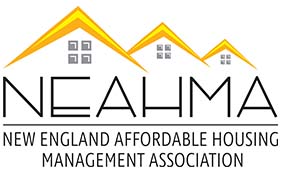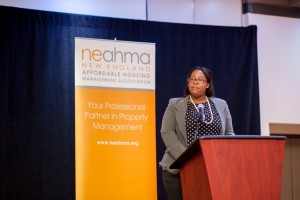By: Shanice Owens, Beacon Communities
This inspiring story was told at the NEAHMA Annual Conference on October 20, 2015
How do you tell your story in 10 minutes? How do you thank all those who’ve played a part in your growth just how much they’ve shaped your actions and outlook on life? Nothing in my life has ever been easy, and this has been one of the most difficult tasks I’ve been faced with to date. Sitting down, writing my story, and telling it to a room full of people.
I studied sociology during my undergrad years and according to the American Sociological Association, sociology is a social science involving the study of the social lives of people, groups, and societies. So imagine being in class and the case study is you. The class is studying a case that mirrors your very existence. The textbooks declaring that children like you, children that have grown up like you have, are destined for jail or a life of living on public assistance. You learn that children similar to you have a very small chance of breaking the cycle of poverty.
Those generations of poverty described in detail: a single mother who works more than one job, struggling to make ends meet, trying to raise children in a public housing project, in a run-down apartment with cement floors. Children witnessing drug sales while walking to the bus stop. Shoot outs and drive-bys are a normal occurrence. The smell of urine permeating the stairwells while drug addicts are begging for money as you walk up 7 flights of stairs with groceries because the elevator was broken and wouldn’t be fixed for some time. Bars on every window, and hallways were laced with graffiti.
The playgrounds were made from metal and the grass had disappeared. All that was left was dirt and broken glass to run and play in. I can still remember the summer day when I wore a pair of sandals and went to play in the playground. I ran home crying to my mother because I had severely cut my foot from the dirt infused with glass. My mother was ashamed at the conditions we were left to live in, but with no college education, this was all she could do.
We lived in Southfield Village in Stamford, CT, often described as one of the most dangerous subsidized housing complexes in the city. But we called it home. We struggled, just as every family in the neighborhood struggled. Sometimes it was uncertain if we would come home to our electricity being shut off. We could not afford to go on lavish vacations, so up until my adult life, I had never even been out of the country or travelled anywhere besides the East coast. However, my brother and I had a roof over our head, food in our stomachs, and a mother who, despite the external circumstances, made sure her children thrived.
This was my reality and according to those textbooks, my reality was not promising. But to say I was lucky makes it seem like the only way to alter this reality was to leave it up to chance. Why is it that only the lucky ones make it out? Why is it that only some, not all, get the opportunity at a life different than what I described?
That was all I had known for 12 years. Until Beacon Communities helped change my reality. Beacon showed us, the residents of Southfield Village, that they deserved more, that we deserved better and that someone actually cared. By definition, Beacon is a guiding light; a shining example of how residents should be treated. I am a firm believer that everything happens for a reason.
So what are the odds that the very Resident Services Coordinator that introduced me to the NAHMA Educational Foundation Scholarship, and helped me finance my college career, is the same individual whose standards I am working to live up to, on this very day? Had it not been for the dedicated individuals like that RSC, I may not have been able to stand before you all to tell my story.
Beacon invested in me. The RSC who worked effortlessly on behalf of the residents in my community, invested in me. The NAHMA Educational Foundation invested in me. At one point, college was a distant ambition of mine; somewhat of an afterthought considering the cost to attend was nearly 5 times my household income. However, The NAHMA Educational Foundation turned that distant ambition into a concrete course.
So many of the youth who live below the poverty line have dreams of attending a post-secondary institution, have excelled in school, and are more than capable of succeeding, yet are thwarted from doing so because they do not have individuals and agencies willing to invest in them and capitalize on the potential they all possess. We have all heard the old saying, “it takes a village to raise a child”; and in my case and many others, this rang true.
If it were not for that village (The NAHMA Educational Foundation, Beacon Communities, and the many others who contributed to my success) I would not be here.
I would not be able to now pay-it-forward to the residents in my community as their Resident Services Coordinator.
Because opportunities for youth like myself to attend college are not handed out as freely as they should, we have to continue to create those opportunities for them. If we continue to invest in them and exist as that guiding light, there will be more people like me, and more occasions where past community residents/scholarship recipients/Resident Service Coordinators can come tell their stories. I am able to understand the daily battles my residents face because I’ve been there.
However, I also know that each resident has the potential to be more than the textbook labels expect of them.
So when you are knee-deep in work, at the office until late in the evening, wondering how you are going to solve the next big crisis, or even questioning if the residents you work with appreciate the sacrifices you have made, just remember that the person sitting on the other side of that desk is worth it. Through me, you can witness the power and strength of a community coming together. I am not only a testament of all of those sacrifices made by individuals like yourselves, I have now become one of you…

